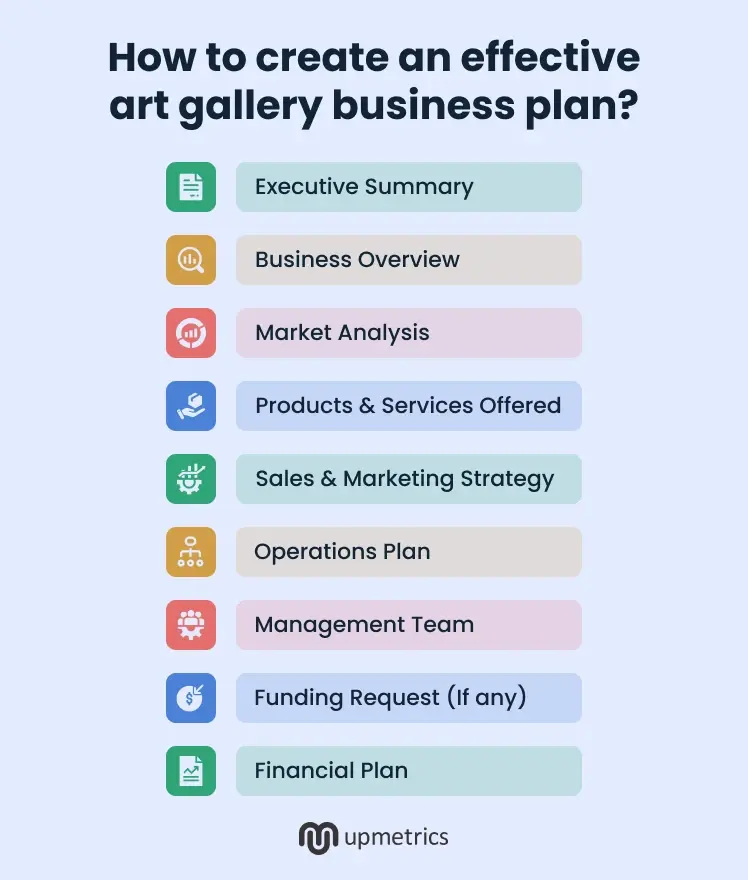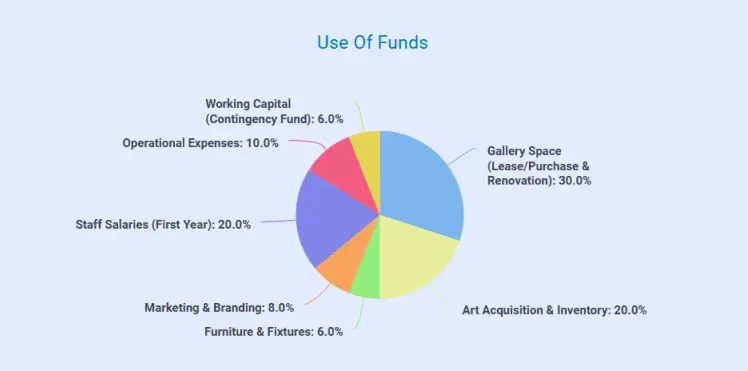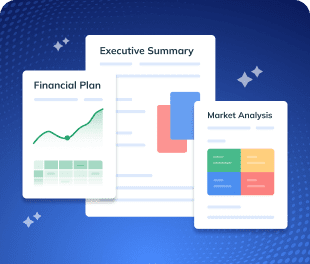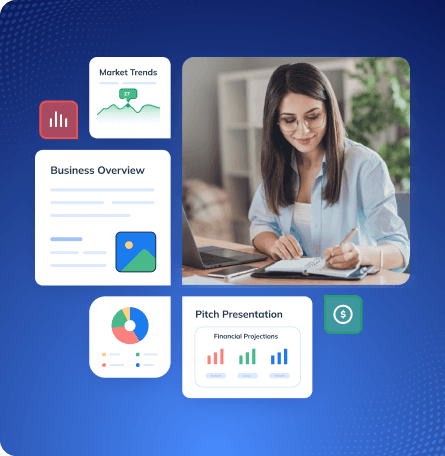Starting an art gallery? Sounds like a dream job, right?
You’ve got to showcase incredible artwork, connect with artists or collectors, and build a space where creativity comes to life.
But making it a reality takes more than just passion. It requires a solid business plan to stay on track, attract buyers, and make sure your gallery makes money (not just memories!).
Wondering how to create one?
No worries; this art gallery business plan template will walk you through what you need to do, along with practical steps. But first…
Why do you need a business plan for an art gallery?
Many people jump into the art world with bigger dreams but no real plan. They assume, “If I put great art on the display, people will show up and buy it.”
But the truth is, a gallery isn’t just about showcasing art—it’s about running a thriving business. And you need a clear strategy to succeed. That’s exactly what a business plan does. It helps you figure out:
👉 Who your buyers are and how to attract them?
👉 How to price your business offerings and sell artwork?
👉 What your expenses are and how to manage them?
👉 How to grow your art gallery and make it profitable?
Without one, you’re just guessing—and in the real world, it often leads to financial struggles and an empty gallery with no visitors.
And we definitely don’t want that.
So, try to create a business plan that works best and makes your art gallery successful and profitable.
How to create an effective art gallery business plan?
In this step-by-step guide, you’ll learn what a winning art gallery business plan includes and how to structure it.

1. Executive Summary
The executive summary is like an elevator pitch for your entire business plan. It gives readers (whether they’re investors, business partners, or even just you) a quick snapshot of what your art gallery is all about and why it will succeed.
Even though it’s the first section, write it last—after you’ve thought through everything else in the plan.
Here’s how to approach your executive summary:
- What’s your gallery about? Contemporary art? Photography? Digital art?
- Where will it be located? A physical space, an online gallery, or both?
- Who will buy the art? Collectors, tourists, businesses, first-time buyers?
- How will you make money? Art sales, events, rentals, consulting?
- Do you need funding? If yes, how much? And what will it be used for?
In short, the main goal of your plan summary is to capture readers’ attention and persuade them to learn more. So, keep it clear, concise, and engaging.
Say goodbye to boring templates
Build your business plan faster and easier with AI
Plans starting from $14/month

2. Business Overview
Now, this section is where you describe your art gallery in detail, including why your gallery exists, what you hope to achieve, and how you’ll run it. Think of it as an introduction to your brand.
Your business overview helps potential investors or stakeholders fully understand the foundational facts of your gallery.
The following are a few key elements that you should cover in this section:
- Your art gallery name & location
- Legal structure (a sole proprietorship, LLC, or nonprofit)
- Your unique concept
- Business owners or partners
- Vision and mission statements
- Short-term & long-term goals
Overall, this section sets the strong basis for your business plan and clearly defines what you want to accomplish. Try to keep it simple, straightforward, yet impactful.
3. Market Analysis
Before you open an art gallery, you need to understand who your customers are, what they’re looking for, and how you can stand out in a competitive industry.
Conducting a thorough market analysis helps you position your gallery effectively and make well-informed business decisions.
This will also enable you to provide insights into your target audience, competitors, and art industry trends. These details will help you create a profitable and well-positioned gallery.
Here’s what to include in market research:
Market size and growth potential
How big is the global art market? Is it growing or shrinking in the USA? What’s the forecast for the next 5-10 years?
Industry trends
What changes happening in the industry? Is digital art growing? Are people investing more in local artists?
Target audience & customer behavior
Understanding your audience is crucial. Who will buy art from your gallery?
- Are they serious collectors looking for investment pieces?
- Do they prefer affordable, trendy artwork for home decor?
- Are you attracting businesses, interior designers, or hospitality industries?
If you better understand your audience, the easier it will be to promote and sell your art. For that, you can develop an effective buyer persona, like this:

Competitive analysis
Look at other galleries in your area or niche. Identify:
- Who are your biggest competitors?
- What kind of art do they sell? What are their strengths and weaknesses?
- How will your gallery offer something unique?
Doing so will help you differentiate yourself and build a stronger business model.
4. Products and Services Offered
An art gallery needs multiple ways to make money. If you only rely on art sales, it can be hard to stay profitable, especially in the early days.
Therefore, you need to offer a mix of products and services that appeal to different customer segments and create multiple revenue streams. For instance, your gallery can sell products like:
- Original artworks (paintings, sculptures, photography, etc.)
- Limited edition prints (affordable alternatives to original pieces)
- NFTs and digital art (if you’re venturing into the digital world)
- Art books and merchandise (posters, books, and gallery-branded items)
In addition, you can offer multiple services for art exhibitions and events, art rentals, consultation, workshops & classes, and gallery space rental.
5. Sales and Marketing Strategy
No matter how amazing artwork you have, it won’t sell itself. You need a sales and marketing strategy to attract visitors and turn them into buyers.
This section is especially important for new galleries to generate sales, build a strong brand from the start, and create long-term relationships with art collectors that make all the difference.
The following are some promotional tactics and methods you might consider including in your plan:
- Developing a user-friendly website to show artists & exhibitions
- Using active social media platforms (Instagram, TikTok, Facebook)
- Creating SEO-optimized content to attract visitors
- Hosting gallery openings, artist talks, and pop-up events
- Networking with influencers and local businesses
- Reaching out to art bloggers, magazines, and journalists
Furthermore, using word-of-mouth marketing can be a powerful way in the art industry—building connections with artists and collectors will help grow your reputation!
6. Operations Plan
Next, your business operations plan details how your art gallery will function behind the scenes. This will help you ensure your business runs effectively on a day-to-day basis.
While planning this section, consider including these things:
Staffing requirements
As the business grows, will you hire staff? Do you need a gallery manager, curators, sales staff, or marketing specialists?
Daily operations
This includes arranging artwork, assisting customers, handling sales, and managing events. If you sell online, add packing and shipping orders as well.
Art handling & storage
What will you do for careful handling and proper storage to avoid damage? Wearing gloves when needed? Keeping fragile pieces in the right climate? Safe packaging for transport?
Supply and inventory management
From where you’ll get artwork? Direct from artists, auctions, consignment agreements? Plus, how will you keep tabs on what’s available, what’s sold, and what needs restocking?
Gallery maintenance
How will you manage regular cleaning, fixing lighting, and keeping walls scuff-free? What do you plan for keeping the space visually appealing and welcoming?
Incorporating these aspects into your operations plan shows potential lenders that you’ve thought through all the operational intricacies and created a solid strategy for smooth operations.
7. Management Team
A strong management team is the backbone of your gallery. As the name suggests, this section introduces the key people responsible for running your gallery.
Even if you’re starting solo, this section should show how you’ll manage operations and scale your team in the future.
If you have a small team of curators & art experts, sales & marketing executives, or event managers, mention their roles, responsibilities, and what experience or skills they bring to your business.
Briefly highlight the external advisors or mentors (if any) and show how they benefit your gallery.
Moreover, you may include a simple organizational chart that clearly outlines the hierarchical structure and how the team is interconnected.
8. Funding Request (If any)
Every gallery owner doesn’t have enough cash to launch their business alone. So, if you need funding, this section explains how much money you need and where it’s coming from.
Here are a few possible funding sources you may consider:
- Traditional bank loans
- Government grants (for the arts)
- Investor partnerships
- Crowdfunding platforms
Also, explain how you’ll use the funds. Investors and lenders won’t invest in your gallery unless they know exactly where it’s going. For instance:

| Category | Exact Amount ($) | Purpose |
|---|---|---|
| Gallery Space (Lease & Renovation) | $150,000 | First-year rent, security deposit, interior renovation, lighting, and display units. |
| Art Acquisition & Inventory | $100,000 | Purchasing or consigning artwork from emerging and established artists. |
| Furniture & Fixtures | $30,000 | Display stands, frames, seating, reception desk, signage. |
| Marketing & Branding | $40,000 | Website development, social media ads, PR events, promotional materials. |
| Staff Salaries (First Year) | $100,000 | Salaries for gallery manager, curators, sales staff, and security. |
| Operational Expenses | $50,000 | Utilities, insurance, legal fees, licenses, and permits. |
| Working Capital (Contingency Fund) | $30,000 | Emergency funds for unforeseen expenses. |
| Total Funding Required | $500,000 | Covers startup and first-year operational costs. |
If you’re taking a loan, clearly explain your repayment plan—how you’ll repay it using business revenue.
9. Financial Plan
The financial plan is a detailed overview of how your art gallery will generate revenue, achieve profitability, and handle potential financial risks.
It not only helps you attract investors and secure funding but also assists you in evaluating the growth potential and long-term financial viability of your gallery.
Here are a few financial projections and reports that you should consider enclosing in your plan:
- Startup costs
- Revenue forecasts
- Operating expenses
- Cash flow estimates
- Income statement
- Balance sheet
- Break-even analysis
Further, describe your potential financial risks and mitigation plans to ensure you’re prepared for challenges.
While drafting, make sure you add easy-to-understand tables and charts to present your financial data more effectively. This will allow investors to make informed decisions easily.
For example, you may consider formulating the financial statements as shown below:
Income Statement (Profit & Loss Statement)
| Category | Year 1 ($) | Year 2 ($) | Year 3 ($) |
|---|---|---|---|
| Revenue | |||
| Artwork Sales (Original & Limited Editions) | 500,000 | 550,000 | 605,000 |
| Art Prints & Merchandise Sales | 50,000 | 55,000 | 60,500 |
| Private Events & Space Rentals | 30,000 | 33,000 | 36,300 |
| Art Consulting & Curation Services | 10,000 | 11,000 | 12,100 |
| Membership & VIP Collector Programs | 10,000 | 11,000 | 12,100 |
| Total Revenue | 600,000 | 660,000 | 726,000 |
| Cost of Goods Sold (COGS) | |||
| Artwork Acquisition & Commissions | (180,000) | (198,000) | (217,800) |
| Production Cost of Art Prints & Merchandise | (20,000) | (22,000) | (24,200) |
| Total COGS | (200,000) | (220,000) | (242,000) |
| Gross Profit | 400,000 | 440,000 | 484,000 |
| Operating Expenses | |||
| Rent & Utilities | (150,000) | (157,500) | (165,375) |
| Staff Salaries & Benefits | (100,000) | (105,000) | (110,250) |
| Marketing & Advertising | (40,000) | (42,000) | (44,100) |
| Event Hosting & Hospitality | (10,000) | (10,500) | (11,025) |
| Website Maintenance & Online Store Fees | (10,000) | (10,500) | (11,025) |
| Shipping & Logistics (Artworks & Merchandise) | (10,000) | (10,500) | (11,025) |
| Insurance & Security | (5,000) | (5,250) | (5,513) |
| Legal & Professional Fees | (5,000) | (5,250) | (5,513) |
| General Maintenance & Supplies | (5,000) | (5,250) | (5,513) |
| Miscellaneous Expenses | (5,000) | (5,250) | (5,513) |
| Total Operating Expenses | (335,000) | (351,000) | (368,550) |
| Operating Profit (EBIT) | 65,000 | 76,000 | 90,000 |
| Interest & Loan Repayments | (5,000) | (6,000) | (7,000) |
| Net Profit Before Tax | 60,000 | 70,000 | 83,000 |
| Taxes (20%) | (12,000) | (14,000) | (16,600) |
| Net Profit After Tax | 48,000 | 56,000 | 66,400 |
Cash Flow Statement
| Category | Year 1 ($) | Year 2 ($) | Year 3 ($) |
|---|---|---|---|
| Opening Cash Balance | 100,000 | 246,000 | 401,300 |
| Cash Inflows: | |||
| Revenue from Sales | 600,000 | 660,000 | 726,000 |
| Private Events & Memberships | 50,000 | 55,000 | 60,500 |
| Sponsorships & Grants | 30,000 | 33,000 | 36,300 |
| Total Cash Inflows | 680,000 | 748,000 | 822,800 |
| Cash Outflows: | |||
| Art Purchases (COGS) | (200,000) | (220,000) | (240,000) |
| Rent & Utilities | (150,000) | (157,500) | (165,375) |
| Staff Salaries | (100,000) | (105,000) | (110,250) |
| Marketing & Advertising | (40,000) | (42,000) | (44,100) |
| Insurance & Miscellaneous | (30,000) | (31,500) | (33,075) |
| Taxes Paid | (14,000) | (18,700) | (24,435) |
| Total Cash Outflows | (534,000) | (574,700) | (617,235) |
| Net Cash Flow (Inflows – Outflows) | 146,000 | 173,300 | 205,565 |
| Ending Cash Balance | 246,000 | 401,300 | 606,865 |
Balance Sheet
| Category | Year 1 ($) | Year 2 ($) | Year 3 ($) |
|---|---|---|---|
| Assets (What the business owns) | |||
| Cash on Hand | 246,000 | 401,300 | 606,865 |
| Accounts Receivable | 20,000 | 22,000 | 24,000 |
| Art Inventory | 100,000 | 110,000 | 120,000 |
| Prepaid Expenses | 10,000 | 11,000 | 12,000 |
| Total Current Assets | 376,000 | 544,300 | 762,865 |
| Fixed Assets (Gallery, Equipment, Fixtures) | 180,000 | 180,000 | 180,000 |
| Total Assets | 556,000 | 724,300 | 942,865 |
| Liabilities (What the business owes) | |||
| Short-term Loans | 30,000 | 20,000 | 10,000 |
| Accounts Payable | 20,000 | 22,000 | 24,000 |
| Taxes Payable | 14,000 | 18,700 | 24,435 |
| Total Liabilities | 64,000 | 60,700 | 58,435 |
| Owner’s Equity (Net Worth of the Business) | |||
| Initial Investment | 500,000 | 500,000 | 500,000 |
| Retained Earnings (Net Profit) | 56,000 | 163,600 | 302,865 |
| Total Equity | 556,000 | 663,600 | 802,865 |
Also, consider describing your exit strategy in this section. This shows potential funders that you keep a plan in place for different scenarios, including how they can recoup their investment if things don’t go as planned.
Download a free art gallery business plan template
Need help writing your art gallery business plan from scratch? Worry not! here you go; download our free art gallery business plan pdf to start.
It’s a modern business plan template specifically designed for your art gallery business. Use this example business plan as a guide while writing your own plan. Also, you can customize it to match your business-specific requirements.
Conclusion
Let’s wrap up! We’ve discussed all the key sections of an art gallery business plan and explained how to draft them. Plus, we’ve shared a free sample plan to help get you started.
So, now it should be much easier for you to write your very own plan.
However, if you’re still seeking an easy way to create your plan, Upmetrics could be your go-to tool.
It’s an AI-powered business planning software that simplifies the entire planning process and lets you generate an actionable business plan in just a few minutes!



